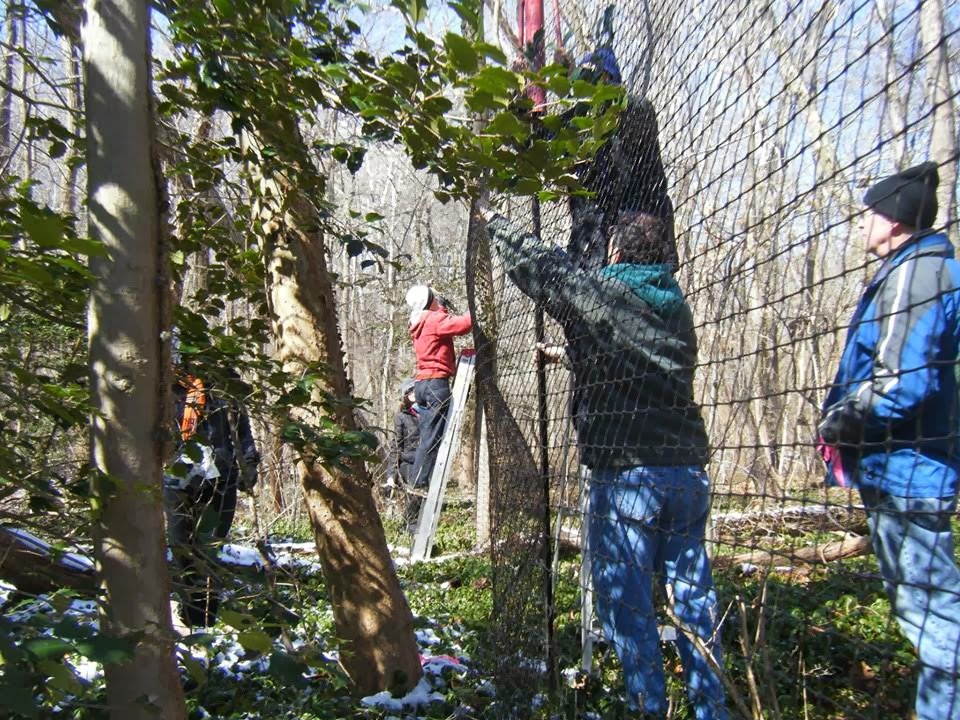Deer Exclosures in Little Falls Park
Cages in the Park - What's that All About?
Volunteers installing a deer exclosure, one of three in the Little Falls Park.
You may have noticed big fences in areas when you are walking along the path in the Park below Massachusetts and Little Falls and wondered what is being caged in.
These are actually "deer exclosures" and they are areas protected from deer by netting wrapped around posts.
The areas are being actively returned to native habitat, which is a multi-step process:
Rid the area of invasives;
Let area rest free of invasive to allow the soil to mend (its nutrients are leeched by invasives);
Add native plants suited areas as available;
Allow the area to seed naturally;
Give the plants the freedom to expand.
There are 3 exclosures (and some other areas of note near them):
The exclosure near the park entrance at Little Falls Parkway and Massachusetts Avenue, on the right, is shady, and protects one of the last areas of Virginia bluebells and wild ginger in the Park;
The exclosure on the left further from Massachusetts Ave. is in a sunny location, and is the recipient of viburnum and hazelnut shrubs.
Further along that side, not enclosed, is swamp milkweed, which is a larval host to the Monarch butterfly and a great nectar plant, and will bloom with a pink flower;
The third exclosure is at the Albemarle entrance to the Park, and while it has many invasives which must be removed, it also has a beautiful grove of holly, and several paw paw and spicebushes, which provide food for songbirds and the Spicebush Swallowtail butterflies and Spicebush Swallowtail Caterpillar. All of these plants are available at Garden stores if you wish to replicate this look in your yard.
Help us Maintain the Exclosures
The exclosures were erected by Montgomery Parks as part of a joint venture between Parks, LFWA, and neighbors of Westmoreland Citizens Association.
If you would like to help with this effort, consider adopting an exclosure under the guidance of a Weed Warrior Supervisor and help us choose names for the exclosures.
If you see vines on the mesh, gently remove the vines.
If you see rips, which would allow deer to enter and strip the seedlings and eat plants, please contact LFWA at info@LFWA.org.
What's the Purpose of the Caged Trees at Little Falls Park?
These cages were established by the same joint venture.
The seedlings are caged to protect them from being stripped by deer.
They include:
Native viburnum, which is a larval food plant for the spring azure butterfly and several moths. Its fruit is eaten by the phoebe, mockingbird, robin, brown thrasher, northern flicker, cardinal, cedar waxwing, vireo, bluebird, and grosbeak. The plant is also used by several bird species for cover and nesting;
Oaks, whose acorns provide food for more than 100 U.S. vertebrate species;
Spicebush , which provide food for songbirds and Spicebush Swallowtail butterflies;
Sycamores, which grow to 60-100 feet tall, have seeds inside the "button balls" which are eaten by American and Purple Goldfinches, Carolina Chickadees, Mallards, Beavers, Muskrats and Squirrels.
If you wish to nurture the growth of these plants and trees, you can help by removing any vines which might climb the cage.
You can gently lift limbs back inside which poke out of the cage.
Please do not push or pull the posts which ground the cage, and if you see that one has snapped, please contact LFWA at info@LFWA.org.
Join your neighbors who have generously donated to make these exclosures and plants possible. You can earmark your donation for Little Falls Park and send it to LFWA.org. All donations are tax deductible.
The restoration of a Park is a long term process, and there are many ways to be involved in it.

